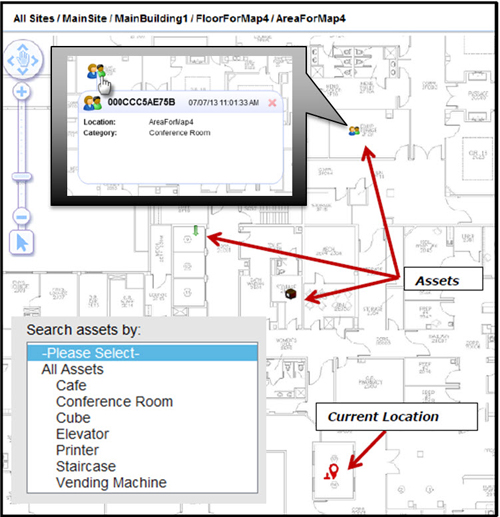Intel‘s newly released fourth-generation Core vPro computer processor comes with a built-in AeroScout active RFID Wi-Fi tag, enabling what Intel calls indoor location-based services (LBS). That, according to AeroScout, means that a computing device using the vPro Generation 4 platform can be located if it comes within range of an enterprise Wi-Fi network, and can be programmed to change its own settings based on that device’s location. Such devices can also identify the locations of other laptops and tablets containing the new processor, as well as assets fitted with AeroScout Wi-Fi RFID tags. Intel officially released the new processor last week, but some laptops, tablets and notebooks containing the technology are already being shipped.
In conjunction with that release, AeroScout—a division of Stanley Black & Decker—is offering a free version of the company’s MobileView application, known as Find Near Me, designed for use with the Intel processor. This app allows a company to identify the locations of tablets or laptops operating on the same Wi-Fi network, and add AeroScout’s Wi-Fi tags to other items that could also be located with one of the mobile devices running the Intel processor.

AeroScout already offers a solution with its MobileView software platform that enables users to locate any device transmitting a Wi-Fi signal within range of an enterprise Wi-Fi network on which the MobileView software is running. With Intel’s Generation 4 vPro processor, however, the device itself can employ AeroScout’s free Find Near Me software application to ascertain such details as where the device is located and what is around it. Based on the device’s location, developers will be able to use an open application programming interface (API), made available with the software, to direct the device to operate according to any business rules a company may have established for that location—for example, blocking certain functions for security purposes.
AeroScout is also offering, at no cost, an Enterprise IT Asset Management application that allows users (who will be IT practitioners, according to Mark Gallant, AeroScout’s VP of industrial marketing) to track the locations of an unlimited number of Wi-Fi-enabled Intel vPro devices within a specific Wi-Fi network, as well as up to 20 AeroScout-tagged items. AeroScout’s Find Near Me and Enterprise IT Asset Management applications are completely free, and do not require a user to purchase the MobileView software. However, Gallant notes, because Find Near Me is limited to location data rather than analytics, users requiring additional information, such as historical data and analytics derived from that data, should purchase the MobileView platform.
Using power from the device itself, the tag built into the vPro platform beacons at preset intervals, transmitting a unique ID number. That ID is received by Wi-Fi access points, and other authorized devices using the Find Near Me software can then locate that device, along with any other such devices within its vicinity. The Enterprise IT Asset Management software will also allow authorized parties to review the locations of all LBS devices and AeroScout tags within the wireless network. The devices containing the new vPro processor are expected to be used most commonly in industrial or corporate environments, Gallant explains, rather than by individual consumers.
To enable the LBS functions, a company’s IT department can download the Enterprise IT Asset Management and Find Near Me versions of MobileView from AeroScout, though those software features are not necessary to simply locate a device. They can load the applications onto one of their servers and then upload their own enterprise maps onto the LBS server, which would reside on their corporate enterprise network.
When a company purchases a laptop or tablet containing a fourth-generation vPro processor, its IT department installs the Find Near Me software on that device. Upon activating the laptop or tablet for the first time, the IT department—or the employee who will be using that device—would need to opt in to the locating system, and then input details regarding the identity that device’s authorized user, along with other parameters, such as how often the device should beacon and what the Wi-Fi network’s service set identifier (SSID) is. The software supports other parameters that developers can control, such as how the device should operate based on its location. For example, if, for security purposes, a business does not want its staff to open specific documents in a cafeteria or other public area, they can stipulate that restriction. A laptop would then be unable to open those documents if it detected that the device was at a non-secure location.
If taken to another location with a different Wi-Fi network, the device would not beacon its ID number if the network’s SSID were not on the pre-set list set up by the IT department. However, developers could create a visitor portal by which, if a businessperson brought his laptop to a client’s site, that client could request that laptop’s MAC address, enter that information into its own system, and track that person’s movements throughout his visit. The client could also determine how much location-related data to enable the visitor to access, such as his own location within the building, as well as details regarding the whereabouts of an individual with whom he may wish to meet, based on the location of that person’s laptop or tablet.
The tag will not beacon if the device is powered off, Gallant says, since it lacks its own power source. However, it will continue to beacon even if the device is in sleep mode.
AeroScout has been working with Intel toward this development for approximately 18 months, Gallant reports, based on requests from both companies’ customers. Many of Intel’s customers have sought a technology that could recognize a device’s location and, as a security feature, shut off specific functions based on that information. For AeroScout, although the Find Near Me and Enterprise IT Asset Management software packages are free, the firm expects many users to opt to purchase the more extensive MobileView platform.
Gallant says he anticipates users will develop a variety of applications that Intel and AeroScout have not yet considered. Customers and developers, he notes, have already told him of several applications they are mulling over. For example, companies could outfit their forklift trucks with on-board tablets made with the fourth-generation Core vPro processor, and the drivers could use the Find Near Me software to determine which items are around them, and then search for the closest specific item within a warehouse. Moreover, maintenance crews could utilize fourth-gen Core vPro-based tablets to pinpoint the specific Wi-Fi-enabled or -tagged equipment that they wish to inspect. And hospital nurses could use the tablets to locate required equipment and supplies within their vicinity.
“I think there will be some really neat kinds of applications that we haven’t even thought about,” Gallant states.
The granularity of location data will depend on the density of access points at any location, Gallant says. In some cases, he adds, users simply want to know in which warehouse bay or building wing a device is located. In others, however, if the access points are spread too thin for the degree of location granularity sought by the users, additional access points would need to be added.


